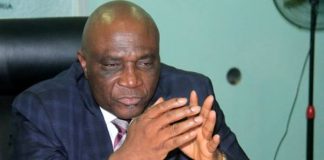🌿 Ruzu Non-Alcoholic Herbal Bitters
Ruzu Non-Alcoholic Herbal Bitters is a natural health supplement specially formulated to:
- ✅ Promote general wellness
- ✅ Detoxify the body
- ✅ Support the treatment of various ailments
Made from a powerful blend of 100% organic and medicinal herbs, Ruzu is completely alcohol-free, making it ideal for:
- 👪 All age groups
- 🌱 Health-conscious individuals
- 🌿 Anyone seeking non-alcoholic herbal remedies
Whether you're looking to boost your vitality, cleanse your system, or support healing the natural way, Ruzu Bitters offers a trusted herbal solution.
Nigeria’s decision to liberalize its currency rate led to the recent devaluation of the naira, which has increased financial strain on many states and dramatically increased their obligations to repay foreign loans.
According to the annual “State of States Report” published by BudgIT, a well-known civic-tech group that promotes fiscal openness in Nigeria, Rivers State has the best fiscal performance, while Lagos State has the largest foreign debt in terms of dollars.
The research emphasizes the financial risks brought to light by the depreciation of the naira, particularly for states like Kaduna, Edo, Ondo, Bauchi, Lagos, Enugu, Ebonyi, and Anambra that have significant debt in dollars. The greatest foreign debt-to-total debt ratios, for example, are 60.54 percent in Edo state and 86.06 percent in Kaduna state.
Nigeria’s subnational debt per capita averaged N40,469 in 2023, indicating that the country’s debt load is not uniform. With an astounding N138,034 in debt per person, Lagos State is the most indebted state overall. One of the most important indicators of a state’s failure risk, according to experts, is net debt per capita: the lower the debt per person, the lower the default risk.
In addition to debt, states have other obligations of N1.19 trillion, such as judgment debts, contractor arrears, backlogs in pension and gratuity payments, wage arrears, and other liabilities.
Read Also: SSANU: No Official Response Yet from FG on Ongoing Strike
Due to a 4.1 percent increase in international debt from $4.43 billion in 2022 to $4.61 billion in 2023 and an N606.12 billion growth in domestic debt, the overall debt stock of Nigeria’s 36 states increased by 38.1 percent, from N7.25 trillion in 2022 to N10.01 trillion. The debt repayment obligations increased by N2.74 trillion in 2024 as a result of the dollar-naira exchange rate’s sharp increase from N899.39 to N1,492.9.
With debts totaling $1.24 billion, or 26.9 percent of the national subnational foreign debt, Lagos continues to be the state with the highest foreign currency debt.
States are ranked according to five criteria in BudgIT’s 2024 report, “Moving Healthcare Delivery from Suboptimal to Optimal.” These include the ability to use Internally Generated Revenue (IGR) to pay for ongoing expenses, the growth of IGR from year to year, the ability to pay for debt obligations and operating costs without borrowing, and debt sustainability metrics like debt as a percentage of revenue, debt as a percentage of total debt, and debt service costs.
Cross River entered the top five in terms of fiscal performance, although Rivers State maintained its top position. Jigawa, on the other hand, saw a sharp fall, falling to 36th. With respective percentages of 121.26 and 118.39 percent, Rivers and Lagos are the only states that produce enough IGR to pay for their operational costs.
While the remaining states rely on federal funding, some states such as Ogun, Anambra, Cross River, Kwara, Kaduna, and Edo are able to produce at least half of their operating expenditures from IGR.
To illustrate their reliance on federal funding, states such as Akwa Ibom, Imo, Taraba, Yobe, Bayelsa, and Jigawa, on the other hand, require more than five times their IGR to cover their operational costs. Notwithstanding these difficulties, the 36 states as a whole were able to pay for their ongoing expenses without taking out new loans.
This accomplishment is noteworthy because it shows how resilient subnational finances are in the face of growing spending. Due in significant part to a 33.19 percent increase in federal allocations brought about by the elimination of the fuel subsidy, the combined revenue of all states in 2023 rose from N6.6 trillion in 2022 to N8.66 trillion, a 31.2 percent gain. N1.24 trillion, or 14.32 percent of the entire state revenue, came from Lagos alone.
Thirteen states rely on federal allocations for at least 70 percent of their income, while 32 states still rely on them for at least 55 percent of their overall income despite revenue growth. States’ susceptibility to fluctuations in oil revenue and other external economic factors is highlighted by this significant reliance.
In 2023, all states’ combined spending rose by 21.19 percent to N9.78 trillion, with Lagos spending the most, disbursing more than N1.49 trillion. Overhead, capital expenditure, and personnel costs all increased by 12.9 percent, 26.75 percent, and 37.3 percent, respectively. N1.25 trillion, or 12.8% of total spending, was needed just to pay off the debt, while N287.56 billion was spent on unreported contractor arrears and pensions.
BudgIT stressed that nations must lessen their reliance on foreign loans in order to achieve fiscal sustainability, particularly in light of exchange rate volatility and budgetary pressures.
Read Also: Breaking: The Tinubu government raises pump prices; see new rates
The Head of Research and Policy Advisory at BudgIT, Iniobong Usen, recommended that states concentrate on generating income through technology, public-private partnerships, natural resources, and prudent budgetary management. Additionally, BudgIT pushed states to use borrowed money for high-impact initiatives with quantifiable financial returns and promoted transparency in debt management.
The study also examined healthcare spending, finding that 36 states only spent N1.39 trillion, or 58.16 percent of their N2.3 trillion budget, on health care. Nine states, including Edo, Ekiti, Katsina, and Ogun, reported not spending any of the money allotted for medical equipment in 2023. Despite spending N15.31 billion on medications and medical supplies and N104.27 billion on the construction and renovation of healthcare facilities, Delta, Ebonyi, and Niger states did not keep track of these expenditures. There is still a lack of facilities, medications, and medical personnel in the healthcare system. Nigeria’s doctor-to-patient ratio is four physicians for every 10,000 patients, which is much lower than the 1:600 ratio that the WHO recommends. At 1:17,959, the ratio is much worse in Taraba State.
Malaria is one of the major infectious illnesses that are a serious hazard. In 2023, there were 527,305 cases of malaria in Borno State, 15,036 of which were severe. Diseases including measles, cholera, and tuberculosis also strike other states, particularly in the north. States’ capacity to successfully manage chronic diseases is hampered by a lack of healthcare infrastructure and staff, and basic healthcare facilities typically serve 8,960 patients each, placing a heavy burden on their limited resources. Long-term stability and resilience in Nigeria’s states depend on enhancing healthcare delivery and economic sustainability in the face of increasing demand on subnational health facilities.
















